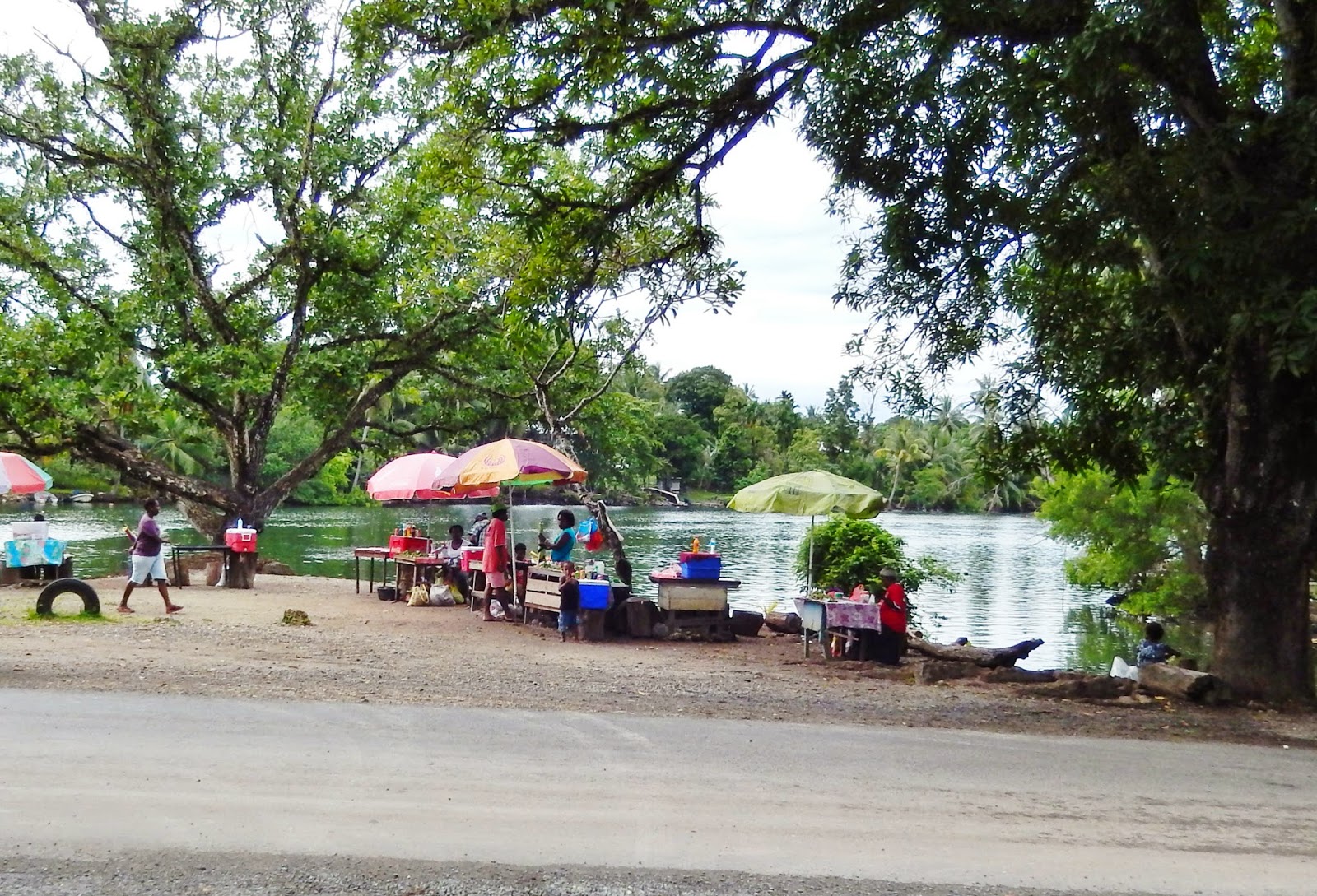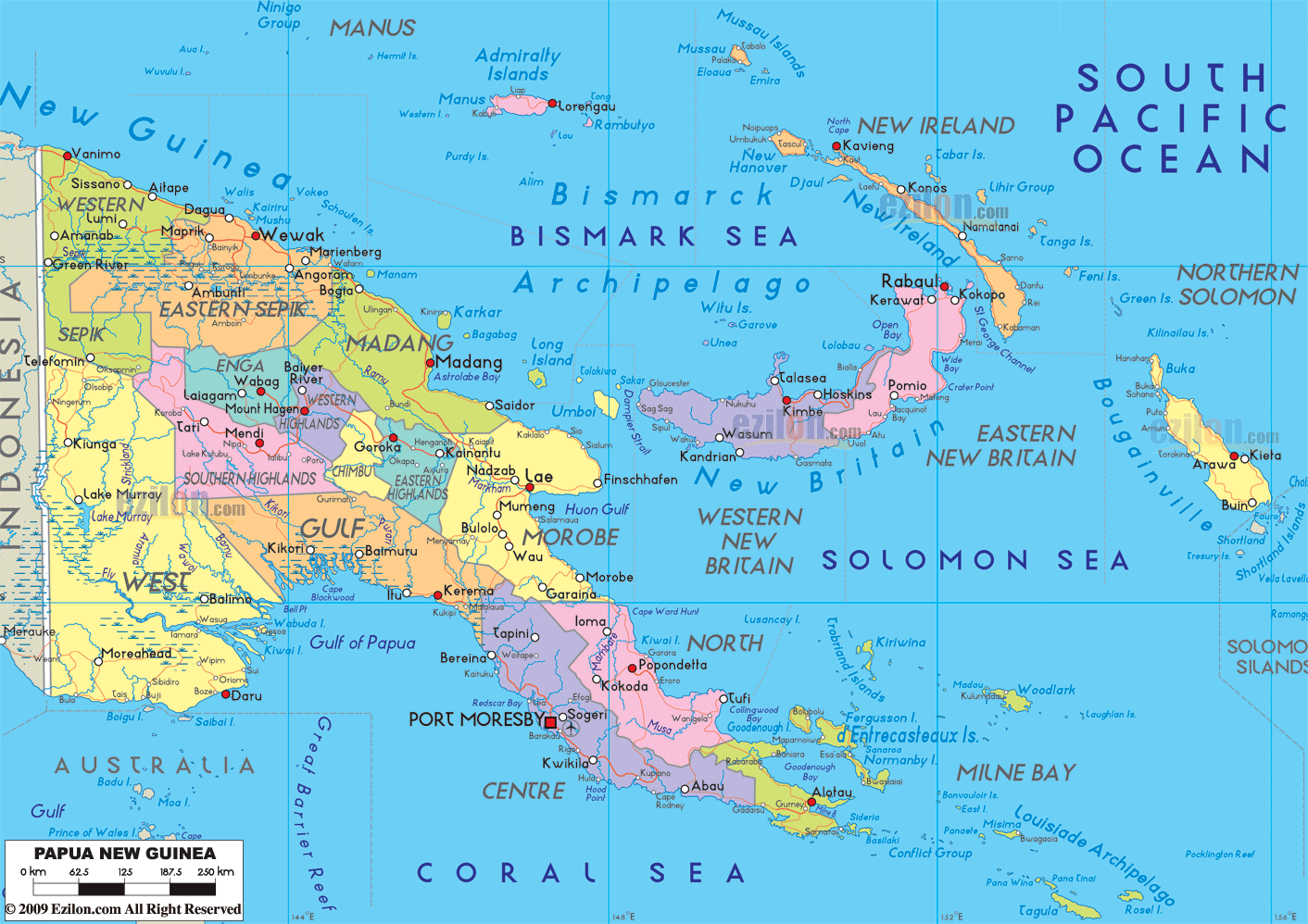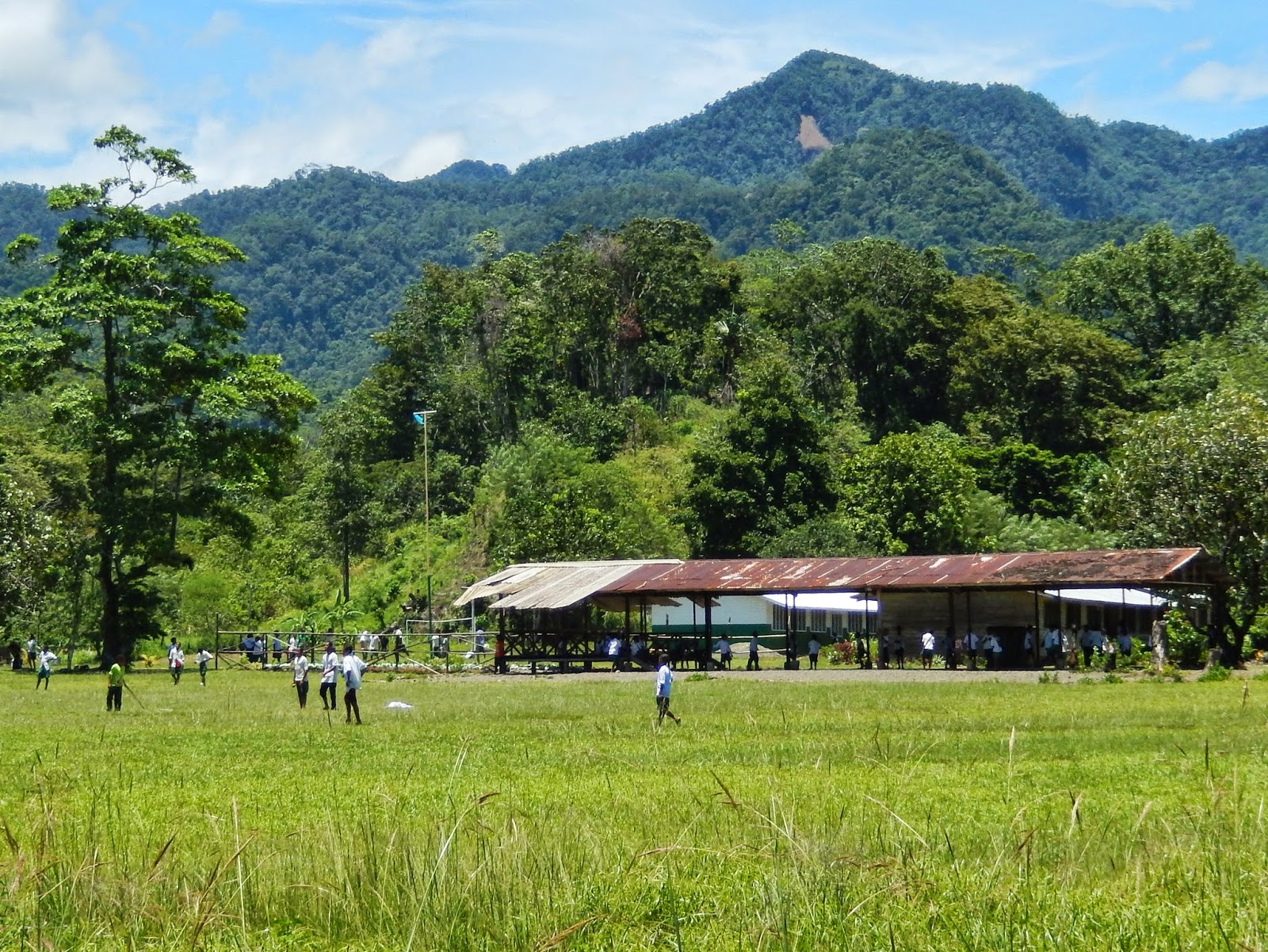We departed
Alotau, Papua New Guinea, at about 5:00 PM on Wednesday, February 19th,
and on Thursday the 20th, we cruised northwest through the Solomon
Sea and past the islands of Bougainville and New Britain. (It was in the
Solomon Sea, southeast of Bougainville Island, that John F. Kennedy’s PT 109
was sunk during World War II. In addition, Bougainville saw very heavy
fighting during World War II.) By the early morning of Friday, February 21st,
we had sailed into the Bismarck Sea north of the island of New Guinea and reached
the northeast coast of Papua New Guinea and Madang Harbor—where we docked at
Main Wharf in the town of Madang.
Madang is the
name of both a Province of Papua New Guinea, and a town in that Province. The
town has a population of about 27,000, and was first settled by Germans in the
1800’s—who were driven out by malaria. Later it came under Australian
administrative control. Madang is on Astrolabe Bay which is part of the
Bismarck Sea. (Astrolabe Bay is named
for the ship of French explorer Jules Dumont d’Urville—who discovered the bay
in 1827.) Madang and Binnen Harbors located in the bay offer protection and
safe moorage from the open waters of Dallman Passage and the Bismarck Sea.
In 1942, Japanese
forces invaded and captured Madang without a fight. Australian forces
recaptured the town in April, 1944, but the town had been virtually destroyed
by the occupation and fighting, so it had to be rebuilt. Before, during, and
after Japanese occupation, “Coastwatchers”—mainly from the Royal Australian
Navy who were living in the area before the Japanese invasion— “watched the
coast” in the Madang region in order to give early warning to Allies of the
approach of Japanese forces. Coastwatchers consisted of both civilians and
military personnel and they performed their task at great personal risk.
Coastwatchers made their first sightings of large Japanese “flying boats” off
the coast of Madang in December 1941. Today, there is an impressive memorial tower
in the town of Madang—which also serves as a working lighthouse—honoring the
Coastwatchers.
Most
passengers on our ship considered our stop in Madang one of our most
forgettable ports. Pat would certainly agree with this assessment, and Bill
would as well except for one very special highlight. At this port, we signed up
for a Holland America tour that would take us on a boat ride through the Madang
Harbor and out into Astrolabe Bay to an “uninhabited island” where we would
have a “relaxing day on the beach” with lunch provided. This excursion was
particularly attractive to Bill because the information describing the tour
indicated that SCUBA diving in the waters around the island was an option. (On
board the ship, Bill and about 7 or 8 others formed a “SCUBA Diving Club” and
several members of the club, like Bill, chose to go on this tour because of
this option.)
When choosing
a tour, passengers are really at the mercy of the written description for the
tour. And of course this description makes every tour option sound absolutely
wonderful. Most of the time, tours
closely match the description and provide good value. But sadly this was not
the case for this tour—and when we discovered this it was too late.
About 8:30 AM,
we met our tour group portside and boarded a bus for the 10 minute ride from
Main Wharf along Coastwatchers Avenue to the Madang Resort. The resort has a
variety of activities available, including shops, restaurants, bars, a PADI
dive shop, and the “Hauskaving” where woodcarvings and other objects made by locals
could be purchased. None of us in the dive club noticed the PADI dive shop at
the resort, and we all boarded the boat assuming that dive equipment would be
available on board.
And at this
point the tour began to unravel. The boat was large (60 feet?) but extremely
crowded! And we couldn’t figure out where all of the people had come from—they
weren’t all on our bus. But some of them were passengers on the ship. What was
going on?
It turns out
that the Captain of the ship realized he could make more money if he charged a
small fee and allowed people onto the boat who weren’t booked on the tour. And
so the boat had a crush of people—most of whom could not find a seat. We were
lucky and were able to get a seat at a table with our friends Mary Martinen (a
member of the SCUBA club) and her brother Tony. But never were we given
any kind of safety briefing—we didn’t even know where the life jackets were.
And if this extremely overcrowded boat got into any kind of an emergency
situation, the result could have been disastrous!
The trip to
the “uninhabited island” took about 45 minutes and we got some good views of
the harbor and its islands. But the day was very overcast, and what we saw was
hardly spectacular.
We arrived at
the island and anchored about 100 yards from the shoreline. And upon arrival at
the island, several things became clear:
1. There was no SCUBA gear available on board.
2. There was a shuttle boat that would take us
from our boat to the shore. But the shuttle held only a small number of
passengers, and it was going to take many trips—and much time—to get everyone
ashore.
3. There were
copious amounts of “debris” in the water—some from vegetation, some “man made.”
4. The beach was practically nonexistent, and the
small beach areas that were there were rocky and not nice—certainly not
somewhere you would want to spend the day!
Bill had
brought his own snorkel gear and he—along with come others—chose not to wait
for the shuttle boat to take him to shore, but rather to jump overboard off our
boat and swim ashore. And this was fine—except that the shallow water had sharp
rocks and when he reached the shore, it was nearly impossible to stand up and
reach land in bare feet. Fortunately he had put his knapsack containing his
aquasox in the shuttle boat, and when the shuttle boat reached shore, friend
Tony got them out and threw them to Bill in the water. And so Bill made it to
dry land!
While Bill was
waiting for Pat to come ashore on the shuttle boat, he did some snorkeling in
the shallow water off shore. (Pat wasn’t game to jump overboard and swim ashore
like Bill did!) And the snorkel there was one of the highlights of the whole
cruise for Bill. Yes the water had floating debris—some of it unpleasant,
although we won’t go into details. But underwater it was spectacular! There were
hundreds of different varieties of brightly colored fish, unspoiled
multi-colored coral of numerous shapes and sizes, nudibranchs in the water and
on the bottom, starfish, bright green eels living among the corals and rocks,
and large lobster-like crustaceans poking their noses out of nooks and
crannies. It was the one dive where Bill really regretted not having an
underwater camera. But the real highlight was observing amphiprions—also known
as “Clown Fish,” or “Nemo” (from the movie). These fish are about 2-3 inches
long and bright orange in color with white circles, patches, and bars. They are
beautiful to look at and their behavior is equally spectacular. Amphiprions
will live among the tentacles of sea anemones for protection from predators.
The tentacles of anemones will not “sting” each other because of chemical
compounds on the surface of the tentacle. (Don’t ask us how this works!)
Amphiprions swim close to the tentacles in order to extract some of this
compound onto their scales which allows them to then shelter within the
tentacles and not get stung. So if a predator appears, amphiprions will dive
for the nearest anemone and predators cannot pursue them for fear of becoming
stung.
This classical
behavior of amphiprions is very famous, and in the past, Bill had seen one or
two amphiprions near an anemone, but not the behavior as described.
However snorkeling at this island showed this in spades. Underwater and about
20 yards off shore there were several large, “dinner-plate sized” anemones each
with 4-5 amphiprions nearby. When Bill waved his hands—which the amphiprions
considered threatening—they dove for the protection of the nearby anemone. And
then—when they perceived the threat was gone, they would slowly come out into
the open. Bill had a great time waving his hands to make the amphiprions go
into the anemones, waiting for them to come out, and then waving his hands
again—over and over. The amphiprions may have become tired of this game, but
Bill didn’t and he spent well over an hour “playing” with them. Sadly, there
was only a handful of people who snorkeled, and Bill was probably the only one
who saw and observed the behavior of the amphiprions.
Eventually Pat
was able to get ashore, but it was not a happy place, and she soon wanted to
return to the boat—as did almost everyone else. Bill, along with Mary and Tony,
stayed as long as we could, with Bill returning to snorkel on the reef several
times. Bill was one of the first ones in the water (jumping overboard) and the
last one to leave the island—his return by shuttle boat. Most people spent
about 15 minutes on the island. Bill was there about 3 hours!
Back onboard
the boat, it was time for lunch—barbecued chicken and pasta. But there wasn’t
enough for everyone on the crowded boat and most people had to stand while they
ate. Fortunately, Mary and Tony were able to get the same table they had before
and we joined them, so we were among the few who were able to eat sitting down
at a table.
At this point,
we were at anchor and everyone was aboard the boat—no one was on the island. After
lunch, the Captain reminded us that this was a “whole day” tour and that there
was plenty of time for people to go back to the island. But a chorus of people
shouted in response: “Just take us back—now!!!” Although Bill had had a great
experience snorkeling, most were extremely disappointed and felt their
experience did not live up the written description of the tour. And they were
not happy about it!
About 1:30 PM
we weighed anchor and the boat took us back to its moorage at Madang Resort.
The trip back was uneventful and it was still an overcast day. Upon our
arrival, Bill and a few others decided to walk back to the ship along
Coastwatchers Avenue—a 30 minute walk—while Pat and most of the other
passengers took the bus back to the ship.
Bill decided
to walk back partly because he wanted to see the woodcarvings and other objects
for sale at the “Hauskaving” inside the resort grounds, and partly because he
was toying with the idea of walking up the hill—in the opposite direction of
where the m/s Amsterdam was docked—to visit the Coastwatchers Memorial
Lighthouse.
At the
“Hauskaving”, Bill ran into our friends Jacob and Margaret George who told him
that the Coastwatchers Memorial was well worth a visit. The objects for sale at the “Hauskaving”,
were interesting—but Bill kept coming back to the idea of “Where am I going to
put this?” and ended up just buying some handmade earrings for Pat.
And then
things started getting just a little bit uncomfortable. Bill started his walk
up to the memorial, but encountered a local who advised him not to go—that
there had been a violent encounter between a visitor and a local. Bill
initially ignored this advice and kept walking. But then he decided it might
not be a good idea to walk into a situation of which he had no knowledge, and therefore
turned around and headed back to the m/s Amsterdam. (We later heard that a
member of the ship’s crew was knocked off of his bicycle and his backpack was
stolen. And this caused a commotion, but fortunately the crew member was not
seriously hurt. We do not know if the backpack was recovered or not.)
And the walk
back was “uncomfortable”—I won’t say scary, but it was uncomfortable. Madang
was not like Alotau, where people were friendly and seemed to be genuinely
curious about us. Walking back along the waterways of Madang, Bill encountered
groups of people—in many cases whole families—selling goods and basically just
“hanging out” along the shoreline. It looked as if people were living there out
in the open. And it all seemed very strange—what were they doing there? They weren’t
all there to sell goods, and there didn’t seem to be any customers. None of the
locals appeared friendly, and since Bill was walking alone, most stared at him
unsmiling—as if “What are you doing here?” As Bill was walking back by himself,
with locals everywhere around him, he remembered that the average Papua New
Guinean lives on about US $1.50/day and that he had over US $300 cash in his
backpack! So that is why it was “uncomfortable” and Bill made a brisk pace back
to the m/s Amsterdam.
Bill arrived
back, and just outside the port gate was a “last chance” to buy handmade
goods—mainly wood carvings—from the locals who were lined up along the roadway.
There was a
huge sign just outside the port gate that read: “Lukautim yu yet long AIDS
Noken koap, stap wantaim wanpela tasol o usim kondom” in Melanesian pidgin with
“Australian Gavman sapotim” and “PNG National AIDS Council” at the bottom. The
sign translates: “Protect Yourself Against AIDS; Abstain From Sex; Be Faithful
to One Partner; Or Use a Condom.” And at the bottom “Australian Government
Support” It turns out that Papua New Guinea has a huge AIDS problem—having
about 70% of HIV cases in the Asia-Pacific sub region.
Back onboard the
m/s Amsterdam the grumbling about the disappointment with the tour—a Holland
America sponsored tour—continued. Many disgruntled passengers wrote letters and
complained to the Shore Excursions Office—which resulted in Holland America
doing something it very, very rarely does—give a partial refund of the tour
price to everyone who was on the tour. Bill felt a little guilty receiving the
refund since he had had such a great snorkeling experience. But he was one of
the very few—maybe the only one—who enjoyed the tour.
The m/s
Amsterdam departed Madang at about 5:00 PM and headed northwest through the
Bismarck Sea. We would have two full “sea days” before our arrival at Yap
Island—part of the Caroline Islands of Micronesia—on Monday February 24th.

















































